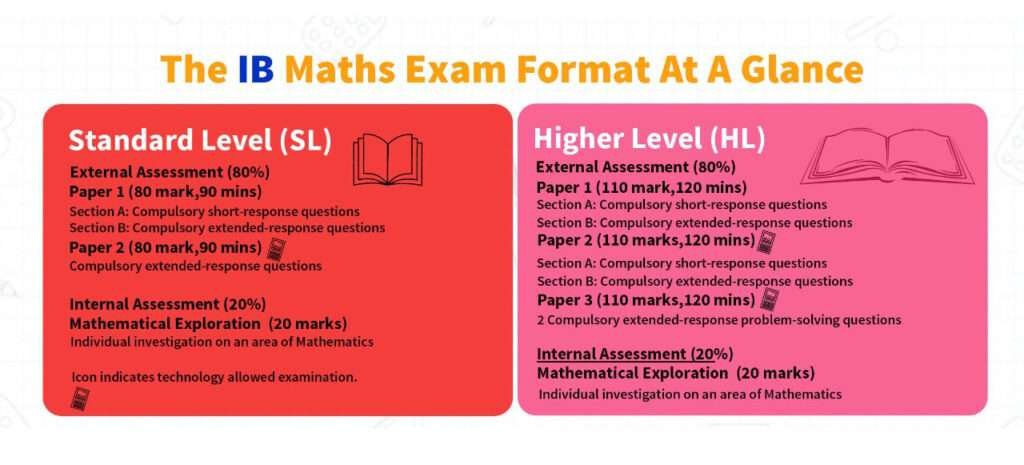The Complete Guide to IB Maths (HL/SL) in Singapore
The International Baccalaureate Diploma Programme (IBDP) aims to provide students with the essential knowledge and real-world skills to prepare them for their further studies in university. As a course that encourages students to develop open-mindedness and intercultural understanding, the IB Curriculum involves the study of a wide range of subjects designed to holistically educate students. During the 2-year course, students are to study 6 subjects, one from each subject group, in addition to completing the central core elements that involve the Theory of Knowledge (TOK) course and the Extended Essay (EE).
With such a rigorous course, you and your child may be rather overwhelmed. As such, our team at MindFlex has put together an Ultimate Guide to IB Maths, including some resources that will be helpful to your child as he/she goes through the IB Maths curriculum.
With such a rigorous course, you and your child may be rather overwhelmed. As such, our team at MindFlex has put together an Ultimate Guide to IB Maths, including some resources that will be helpful to your child as he/she goes through the IB Maths curriculum.
1. An Overview to IB Maths
IBDP students are expected to study one course from each subject group, Group 1 to Group 6. Under Group 5, there are 2 Mathematics subjects which are Mathematics: Applications and Interpretation (AI) and Mathematics: Analysis and Approaches (AA), with AA being the more commonly-taken Maths subject. Doing well in IB Maths is imperative for your child to not only achieve good results in the IBDP Curriculum, but is also important for him/her to develop creative and logical thinking that is necessary to thrive in our data-rich world today.
Unlike the A Levels where students sit for one exam at the end of JC, the IBDP Curriculum involves multiple components where students are assessed throughout the curriculum via Internal and External Assessments. This means that IB Maths students have to be consistent in their learning and revision of the IB Maths syllabus throughout the duration of the curriculum. In addition, they have to pick up skills such as mathematical thinking and quantitative reasoning.
Developing such skills require immense critical thinking and are not easy to master. Here at MindFlex, we have a large pool of experienced IB Maths tutors ranging from part-time tutors to ex-MOE teachers to help your child in their IB Maths journey. Request for one of our Top Maths Tutors today!
2. Difference between SL (Standard Level) and HL (Higher Level) in IB Maths
Mathematics: Analysis and Approaches involves a heavy focus on constructing, communicating and justifying mathematical arguments that are logically sound. Before delving into the specifics of the IB Maths curriculum, it is important that we first understand the key differences between SL Maths and HL Maths.
Of course, the main difference between SL and HL Maths (AA) is the rigour and intensity of the course. SL Maths requires students to be comfortable manipulating algebraic expressions and recognising patterns. They are also required to demonstrate an understanding of the mathematical generalisation of patterns.
On the other hand, HL Maths is more demanding as it requires students to have a strong foundation in algebraic skills and manipulation, and have an understanding of simple proofs. On top of that, the Maths questions that they will face in examinations will be more challenging and require more higher-order thinking.
3. Objectives of IB Maths
The primary objective of the IB Maths course is to give students knowledge of Mathematical facts and concepts, and inculcate in twenty-first century problem-solving and reasoning skills.
The following Assessment Objectives are aimed towards encouraging students to hone these skills.
1. Knowledge and understanding
IB Maths Students are expected to demonstrate an ability to understand, recall and appropriately use Mathematical concepts and techniques in any context, be it familiar or unfamiliar.
2. Problem Solving
On top of knowing Mathematical facts, IB Maths students are also required to be able to select and apply their knowledge to solve various problems, in both real-world contexts as well as in abstract problems.
3. Communication and interpretation
IB Maths students are expected to translate real-world problems into Mathematics, and bring their mathematical knowledge into common real-world situations. In addition, they should be able to demonstrate an understanding of the appropriate technology and notations to be used in various different contexts.
4. Technology
IB Maths students should understand how to use technology appropriately to solve Mathematics problems and explore different ideas.
5. Reasoning
As IB Maths students, students should know how to create logically sound and precise Mathematical statements, inferences and deductions.
6. Inquiry Approaches
IB Maths students are expected to systematically and logically investigate various situations in both real-world and abstract concepts. This involves organising information and analysing it in a systematic manner, drawing logically sound conclusions and testing their validity.
4. IB Maths Exam Format
The IB Maths (AA) assessment consists of both Internal Assessments and External Assessments. The Internal Assessment, making up 80% of the total grade, includes Paper 1 (Short-response questions), Paper 2 (Extended-response questions) and Paper 3 (Extended-response questions, for HL Maths students only). The External Assessment, which makes up 20% of the total grade, involves Mathematical Exploration. In terms of assessment components, the IB Maths assessment differs from SL to HL, as shown below.

4.1. Standard Level (SL)
External Assessment (3 hours, 80%)
Paper 1 (90 minutes)
No technology allowed. (80 marks, 40%)
Section A:
Compulsory short-response questions based on the syllabus.
Section B:
Compulsory extended-response questions based on the syllabus.
Paper 2 (90 minutes):
Technology required. (80 marks, 40%)
Section A:
Compulsory short-response questions based on the syllabus.
Section B:
Compulsory extended-response questions based on the syllabus.
Internal Assessment (20%)
This component is first internally assessed by the teacher and then externally moderated by the IB at the end of the course.
Mathematical Exploration
Students are to individually investigate an area of mathematics and write a piece on it. (20 marks)
4.2. Higher Level (HL)
External Assessment (5 hours, 80%)
Paper 1 (120 minutes):
No technology allowed. (110 marks, 30%)
Section A:
Compulsory short-response questions based on the syllabus.
Section B:
Compulsory extended-response questions based on the syllabus.
Paper 3 (60 minutes)
Technology required. (55 marks, 20%)
Two compulsory extended response problem-solving questions.
Internal Assessment (20%)
This component is first internally assessed by the teacher and then externally moderated by the IB at the end of the course.
Mathematical Exploration
Students are to individually investigate an area of mathematics and write a piece on it.
More information can be found under the IB Syllabus.
